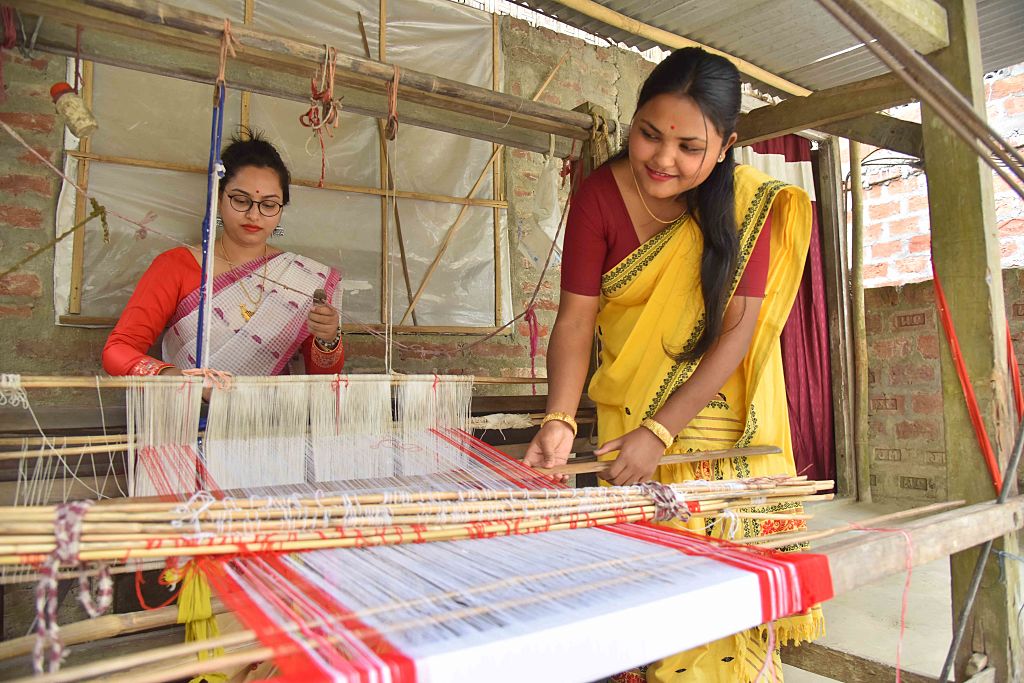Amid the intensifying trade tariff war and changing geopolitical dynamics, India stands resolute in protecting its sovereignty and economic stability for global prosperity. Boasting robust fundamentals and the world’s fastest-growing economy, set to leapfrog to the third largest by 2030, India is strategically advancing its flagship Make-in-India initiative to achieve self-reliance. Prime Minister Narendra Modi’s visionary leadership has reinvigorated the Swadeshi campaign, spotlighting indigenous industries. Among these, the Indian handloom sector, one of the world’s oldest cottage industries, holds immense potential to set new benchmarks.
With a heritage spanning millennia, it embodies India’s vibrant culture and masterful craftsmanship. As India celebrates 79th Independence Day, the handloom industry stands as a vibrant symbol of Swadeshi Jagran under Prime Minister Narendra Modi’s leadership, weaving together the nation’s rich cultural heritage and economic self-reliance through the skilled hands of millions of artisans.
The Ministry of Textiles, partnering with the National Handloom Development Corporation (NHDC), marked the 11th National Handloom Day on August 7 by unveiling an Exclusive Handloom Expo and introducing the innovative “Haat on Wheels” mobile retail project at Handloom Haat in New Delhi. This initiative drives home a clear message that the PM Modi government has had steadfast dedication to safeguarding and promoting India’s age-old weaving traditions. Handlooms represent not just a cornerstone of the nation’s cultural heritage but also a vital source of income for millions of rural weavers, bolstering the rural and socio-economic landscape.
Over the past five years, handloom schemes have benefited over 644,985 weavers and 510,320 artisans nationwide, underlining the scale of government outreach. Among them, Tamil Nadu supported around 125,463 weavers and 13,806 artisans, while Uttar Pradesh assisted 120,818 weavers and 104,054 artisans, highlighting the spread of support across diverse geographies.
These schemes span the National Handloom Development Programme (NHDP), Raw Material Supply Scheme, Comprehensive Handicrafts Cluster Development Scheme, and Weavers’ MUDRA Scheme. They provide essential aid in the form of raw materials, upgraded looms, design innovation, infrastructure, marketing assistance, concessional credit, and social security.
In Odisha, for instance, more than 34,538 weavers and 16,210 artisans received benefits in the last five years. This local impact reflects how central government schemes reach state levels effectively. Across states, the handloom sector is gaining new momentum through innovative policies and ambitious investment. In Arunachal Pradesh, the government launched the Handloom and Handicrafts Policy 2025 on National Handloom Day, aiming to empower tribal weavers and preserve cultural heritage through structured support.
In Meghalaya, celebrations marked the GI tagging of Ryndia and Khasi handloom products, reinforcing both identity and economic value. The sector supports over 40,000 farmers and more than 42,000 individuals, mostly women, reaffirming the dual benefit of cultural preservation and women’s empowerment.
Similarly, Odisha is implementing bold plans to elevate its textile industry through the EKTA exhibition and textile summit. The state has engaged more than 1.3 lakh weaving assistants across 30 districts. Under new policies, it aims to establish six textile parks, modernize infrastructure, and sign MoUs worth Rs 7,808 crore—generating more than 53,300 jobs in textiles and apparel.
On the national level, a range of schemes propels this transformation. The NHDP offers financial support for clusters, looms, design improvement, marketing, and infrastructure. The Raw Material Supply Scheme ensures affordable yarn supply with freight and price subsidies. The Weaver MUDRA Scheme provides concessional loans with margin assistance and credit guarantee. The Comprehensive Handloom Cluster Development Scheme is expanding mega clusters in cities such as Varanasi, Murshidabad, Virudhanagar, Guntur, Bhagalpur, and more, with up to Rs 30 crore support per cluster.
Budget 2025 further consolidated this support. It announced Rs 200 crore for NHDP, Rs 600 crore for the Cotton Mission (securing raw materials), Rs 635 crore for the Amended Technology Upgradation Fund Scheme to modernize the textile industry, Rs 1,948 crore for research and capacity building, and Rs 260 crore for handicraft sector development.
These schemes also prioritize social security and welfare. Under the Handloom Weavers’ Comprehensive Welfare Scheme, weavers receive insurance coverage, scholarships, and more through components like PMJJBY, PMSBY, and MGBBY. Education access is enhanced through partnerships with IGNOU and NIOS. The Hathkargha Samvardhan Sahayata covers 90% of upgraded loom costs for eligible weavers. This extensive framework aligns perfectly with the vision of Viksit Bharat and Aatmanirbhar Bharat, where local talent and craft drive global relevance. Prime Minister Modi once said on National Handloom Day: “Today is a day to celebrate our rich weaving traditions, which showcase the creativity of our people.” His words echo the pride and potential of the handloom community.
All in all, handloom in India is emerging as more than a preservable tradition—it’s a dynamic engine of economic empowerment, rural employment, cultural identity, and innovation. The staggering reach—over 6.4 lakh weavers and 5.1 lakh artisans benefitted in the last five years—alongside state-specific successes in Odisha, Arunachal Pradesh, Meghalaya, Uttar Pradesh, Tamil Nadu, and Andhra Pradesh, showcases the sector’s transformative power. From financial schemes to scholarships, from infrastructure to global marketing, India is weaving a future that’s rooted in heritage and stepping confidently into modern markets.















